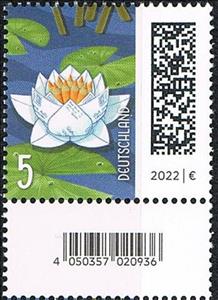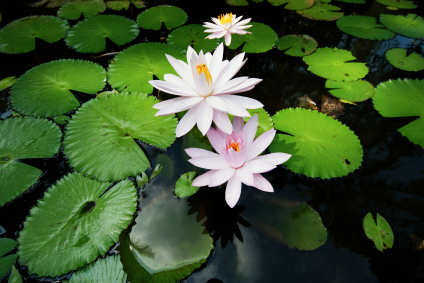Stamp with Attached Label: Letters as Lotus Flower (Germany, Federal Republic 2021)
Letters as Lotus Flower (Germany, Federal Republic 2021)
02 December (Germany, Federal Republic ) within release World of the Letter Definitives (2021-) goes into circulation Stamp with Attached Label Letters as Lotus Flower face value 5 Euro cent
| Stamp with Attached Label Letters as Lotus Flower in catalogues | |
|---|---|
| Michel: | Mi: DE 3644SZd1 RIb |
Stamp with Attached Label is square format.
Coil stamp with attached code label below Coil Stamps size of the counting number always 2.5mm high b=closed "4" in the gutter (EAN code)Also in the issue World of the Letter Definitives (2021-):
- Mini Sheet - Letters as Bird face value 10*85;
- Stamp - Letters as Bird face value 85;
- Mini Sheet - Letters as Bird face value 10*85;
- Stamp - Letters as Bird face value 85;
- Mini Sheet - Letters as Kite face value 10*160;
- Stamp - Letters as Kite face value 160;
- Mini Sheet - Letters as Kite face value 10*160;
- Stamp - Letters as Kite face value 160;
- Stamp - Letters as Lotus Flower face value 5;
- Mini Sheet - Letters as Lotus Flower face value 10*5;
- Stamp - Letters as Lotus Flower face value 5;
- Mini Sheet - Letters as Lotus Flower face value 10*5;
- Stamp - Letters as Ship face value 100;
- Mini Sheet - Letters as Ship face value 10*100;
- Stamp - Letters as Ship face value 100;
- Mini Sheet - Letters as Ship face value 10*100;
- Gutter Pairs - Letters as Bird face value 2*85;
- Stamp with Attached Label - Letters as Bird face value 85;
- Stamp with Attached Label - Letters as Bird face value 85;
- Stamp with Attached Label - Letters as Bird face value 85;
- Gutter Pairs - Letters as Bird face value 2*85;
- Gutter Pairs - Letters as Bird face value 2*85;
- Stamp with Attached Label - Letters as Bird face value 85;
- Stamp - Letters as Bird face value 85;
- Stamp with Attached Label - Letters as Lotus Flower face value 5;
- Gutter Pairs - Letters as Lotus Flower face value 2*5;
- Gutter Pairs - Letters as Kite face value 2*160;
- Stamp with Attached Label - Letters as Kite face value 160;
- Stamp with Attached Label - Letters as Kite face value 160;
- Gutter Pairs - Letters as Kite face value 2*160;
- Gutter Pairs - Letters as Kite face value 2*160;
- Stamp with Attached Label - Letters as Kite face value 160;
- Stamp with Attached Label - Letters as Kite face value 160;
- Stamp - Letters as Kite face value 160;
- Stamp with Attached Label - Letters as Ship face value 100;
- Gutter Pairs - Letters as Ship face value 2*100;
- Stamp - Letters as Bird face value 85;
- Stamp - Letters as Bird face value 85;
- Stamp - Letters as Bird face value 100;
- Stamp - Letters as Bird face value 100;
- Stamp - Letters as Bird face value 160;
- Stamp - Letters as Bird face value 160;
- Stamp - Letters as Bird face value 160;
- Stamp - Letters as Bird face value 2*85;
Stamp with Attached Label Letters as Lotus Flower it reflects the thematic directions:
Aquatic plants are plants that have adapted to living in aquatic environments (saltwater or freshwater). They are also referred to as hydrophytes or macrophytes. These plants require special adaptations for living submerged in water, or at the water's surface. The most common adaptation is aerenchyma, but floating leaves and finely dissected leaves are also common.
The principal factor controlling the distribution of aquatic plants is the depth and duration of flooding. However, other factors may also control their distribution, abundance, and growth form, including nutrients, disturbance from waves, grazing, and salinity.
Aquatic vascular plants have originated on multiple occasions in different plant families; they can be ferns or angiosperms (including both monocots and dicots). Seaweeds are not vascular plants; rather they are multicellular marine algae, and therefore are not typically included among aquatic plants. A few aquatic plants are able to survive in brackish, saline, and salt water. Examples are found in genera such as Thalassia and Zostera. Although most aquatic plants can reproduce by flowering and setting seed, many also have extensive asexual reproduction by means of rhizomes, turions, and fragments in general.
One of the largest aquatic plants in the world is the Amazon water lily; one of the smallest is the minute duckweed. Many small aquatic animals use plants like duckweed for a home, or for protection from predators, but areas with more vegetation are likely to have more predators. Some other familiar examples of aquatic plants might include floating heart, water lily, lotus, and water hyacinth.
Some aquatic plants are used by humans as a food source. Examples include wild rice (Zizania), water caltrop (Trapa natans), Chinese water chestnut (Eleocharis dulcis), Indian lotus (Nelumbo nucifera), water spinach (Ipomoea aquatica), and watercress (Rorippa nasturtium-aquaticum).
A flower, sometimes known as a bloom or blossom, is the reproductive structure found in plants that are floral (plants of the division Magnoliophyta, also called angiosperms). The biological function of a flower is to effect reproduction, usually by providing a mechanism for the union of sperm with eggs. Flowers may facilitate outcrossing (fusion of sperm and eggs from different individuals in a population) or allow selfing (fusion of sperm and egg from the same flower). Some flowers produce diaspores without fertilization (parthenocarpy). Flowers contain sporangia and are the site where gametophytes develop. Many flowers have evolved to be attractive to animals, so as to cause them to be vectors for the transfer of pollen. After fertilization, the ovary of the flower develops into fruit containing seeds. In addition to facilitating the reproduction of flowering plants, flowers have long been admired and used by humans to beautify their environment, and also as objects of romance, ritual, religion, medicine and as a source of food.
Flora is the plant life occurring in a particular region or time, generally the naturally occurring or indigenous—native plant life. The corresponding term for animal life is fauna. Flora, fauna and other forms of life such as fungi are collectively referred to as biota. Sometimes bacteria and fungi are also referred to as flora, as in the terms gut flora or skin flora.



